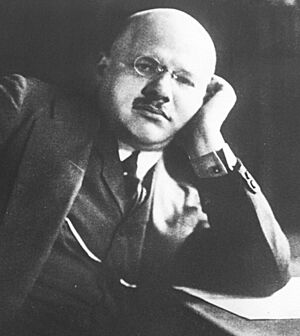Leo Fall facts for kids
Leopold Fall (born February 2, 1873 – died September 16, 1925) was a talented Austrian composer. He was especially known for writing operettas, which are like light operas with singing and speaking parts. He also worked as a Kapellmeister, which means he was a music director, often leading an orchestra or choir.
About Leo Fall's Life
Leo Fall was born in a city called Olmütz (now Olomouc) in what is now the Czech Republic. His father, Moritz Fall, was also a bandmaster and composer, and he taught Leo a lot about music.
Leo later studied music at the Vienna Conservatory in Vienna, Austria. His teachers there were Robert Fuchs and Johann Nepomuc Fuchs. After his studies, he joined his father in Berlin.
In 1895, Leo started a new career as a conductor for operettas in Hamburg. This is where he began to compose his own music. From 1904 onwards, he focused mainly on writing music.
Even though another famous composer named Franz Lehár was more successful at the time, Leo Fall was still very good at creating beautiful melodies and well-arranged music. He worked in cities like Berlin, Hamburg, and Cologne before settling in Vienna in 1906. He passed away in Vienna and is buried in the Vienna Central Cemetery.
Some of his most famous operettas that were popular in English-speaking countries include The Dollar Princess and Madame Pompadour. These shows were very successful in London and New York. His operetta Der liebe Augustin (also known as Princess Caprice in London) was performed an amazing 3,360 times!
Leo Fall's Stage Works
Leo Fall wrote music for many plays and also composed three operas, though these were not as successful. He is best known for his operettas, which were very popular during a time known as the "Silver Age" of Vienna operetta.
Operas:
- Paroli oder Frau Denise (1902)
- Irrlicht (1905)
- Der goldene Vogel (1920)
Operettas:
- Der Rebell (Vienna, 1905) – later rewritten as Der liebe Augustin
- The Merry Farmer (Der fidele Bauer, Mannheim, 1907)
- Die Dollarprinzessin (Vienna, 1907) – adapted into English as The Dollar Princess (1909)
- Die geschiedene Frau (Vienna, 1908) – adapted into English as The Girl in the Train (1910)
- Der Schrei nach der Ohrfeige (Vienna, 1909)
- Brüderlein fein (Vienna, 1909)
- Das Puppenmädel (Vienna, 1910)
- Die schöne Risette (Vienna, 1910)
- Die Sirene (Vienna, 1911) – adapted into English as The Siren (1911)
- The Eternal Waltz (London, 1911)
- Der liebe Augustin (Berlin, 1912) – also known as Princess Caprice
- Die Studentengräfin (Berlin, 1913)
- Der Nachtschnellzug (Vienna, 1913)
- Der Frau Ministerpräsident (Berlin, 1914)
- Der künstliche Mensch (Berlin, 1915)
- Die Kaiserin (Fürstenliebe) (Berlin, 1916)
- The Rose of Stamboul (Vienna, 1916)
- Die spanische Nachtigall (Berlin, 1920)
- Der heilige Ambrosius (Berlin, 1921)
- Die Straßensängerin (Vienna, 1922)
- Madame Pompadour (Berlin, 1922)
- Der süße Kavalier (Berlin, 1923)
- Jugend im Mai (Dresden, 1926)
See also
 In Spanish: Leo Fall para niños
In Spanish: Leo Fall para niños


